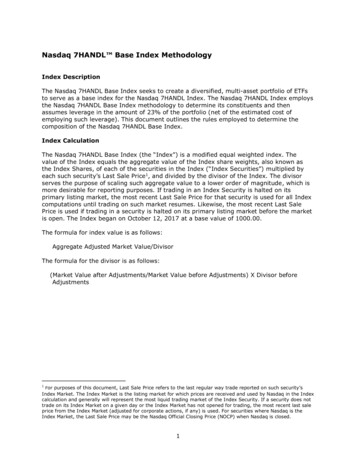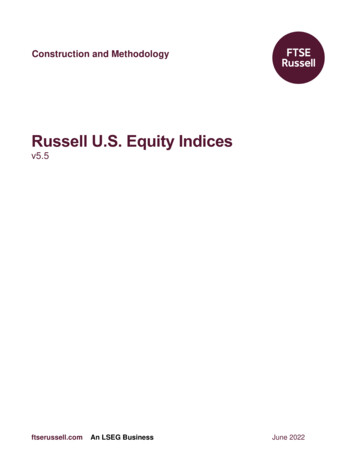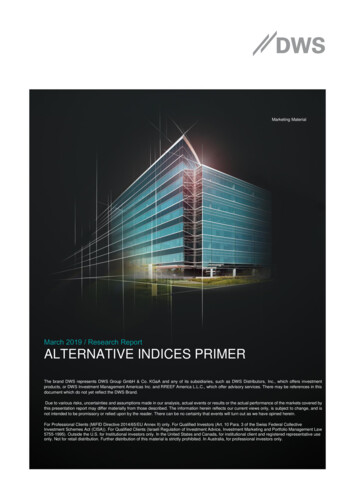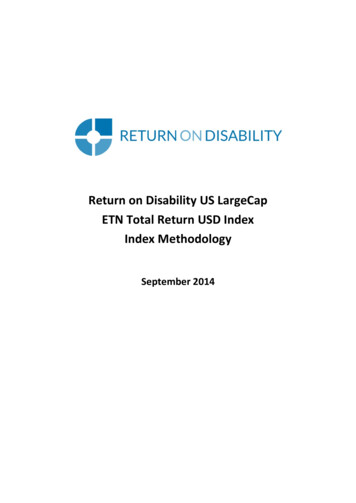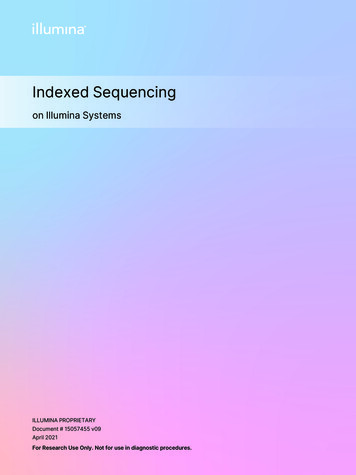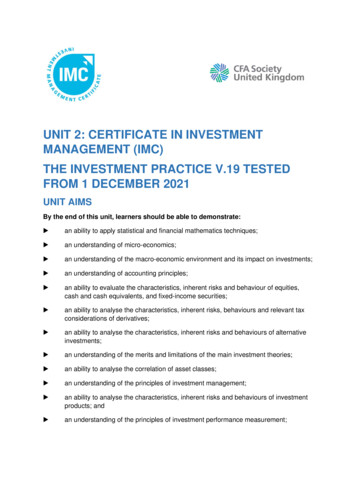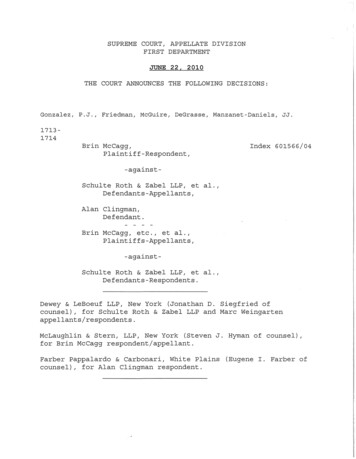
Transcription
SUPREME COURT, APPELLATE DIVISIONFIRST DEPARTMENTJUNE 22, 2010THE COURT ANNOUNCES THE FOLLOWING DECISIONS:Gonzalez, P.J., Friedman, McGuire, DeGrasse, Manzanet-Daniels, JJ.17131714Brin McCagg,Plaintiff-Respondent,Index 601566/04-againstSchulte Roth & Zabel LLP, et al.,Defendants-Appellants,Alan Clingman,Defendant.Brin McCagg, etc., et al.,Plaintiffs-Appellants,-againstSchulte Roth & Zabel LLP, et al.,Defendants-Respondents.Dewey & LeBoeuf LLP, New York (Jonathan D. Siegfried ofcounsel), for Schulte Roth & Zabel LLP and Marc Weingartenappellants/respondents.McLaughlin & Stern, LLP, New York (Steven J. HYman of counsel),for Brin McCagg respondent/appellant.Farber Pappalardo & Carbonari, White Plains (Eugene I. Farber ofcounsel), for Alan Clingman respondent.
Order, Supreme Court, New York County (Bernard J. Fried,J.), entered August 4, 2008, which, insofar as appealed from aslimited by the briefs, granted plaintiff's cross motion to add adissolved Delaware corporation as an additional party plaintiffon his seventh cause of action against defendants Schulte Roth &Zabel LLP and Marc Weingarten (the SRZ defendants)for aidingand abetting an alleged breach of fiduciary duty, and denied theSRZ defendants' motion to dismiss the seventh cause of action tothe extent that cause of action was brought on behalf of thedissolved corporation, unanimously reversed, on the law, withcosts, plaintiff's cross motion denied, and the SRZ defendants'motion to dismiss the seventh cause of action granted.Order,same court and Justice, entered January 26, 2009, which grantedmotions by defendant Alan Clingman and the SRZ defendants todismiss the amended complaint with prejudice, unanimouslymodified, on the law and the facts, and in the exercise ofdiscretion (1) to dismiss the action with prejudice unless,within 30 days after service of a copy of this order with noticeof entry, plaintiff serves a new amended complaint that comportswith the court's prior orders entered September 26, 2005 andAugust 4, 2008 but asserts only the claims remaining againstdefendant Clingman, and (2) to direct that plaintiff pay2
defendants the reasonable attorneys' fees and other reasonableexpenses they incurred in connection with the filing of theamended complaint, and otherwise affirmed, without costs.TheClerk is directed to enter judgment dismissing the action asagainst the defendants Schulte Roth & Zabel LLP and MarcWeingarten.In 2000 and 2001, defendant Clingman and others formed acompany called Marquis Jet Partners, Inc.Marquis is one of ahandful of fractional jet ownership companies that maintainfleets of aircraft and sell the rights to travel on those planesfor fixed periods of time to frequent users of jet travel.August 2002, Marquis terminated Clingman.Cling anInretained 12%of Marquis common stock, and refused an offer to sell back hisshares and sign a non-compete agreement.In November of the same year, Clingman invited plaintiffMcCagg to attend a meeting in Florida with the senior managementof Flexjet/Bombardier, a Canadian jet manufacturer.The purposeof the meeting was to discuss creating a company to compete withMarquis.Clingman allegedly thought the new company could havea competitive advantage over Marquis by offering the sale ofairplane usage in smaller blocks of time.McCagg and Clingman decided to pursue the venture.OnDecember 17, 2002, the law firm of Schulte Roth & Zabel (SRZ) ,3
handled the incorporation of the corporation, which was calledClearjets, in the State of Delaware.SRZ had done legal workfor Clingman, and he recommended it to McCagg to handle theincorporation.Two days later, on December 19, 2002, Marquis's counseldemanded that Clingman abandon any plans to engage in anyventure that would compete with his former firm.The letterthreatened that if Clingman did not accede, Marquis would takenecessary legal action to protect its rights.letter dated December 24, 2002.SRZ responded byThe correspondence stated,among other things, that Clingman had been terminated byMarquis, that he was not given any severance when he wasterminated, that he had not executed a non-competitionagreement, and that he was not otherwise bound to suspendinvolvement in any competing venture in the industry.Next, on January 1, 2003, McCagg and Clingman both signed aone page "Letter of Agreement H outlining their mutual duties as"Partners H in the venture.The letter states:"1. The Partners agree to contribute the fractional privatejet business into a mutually owned LLC (the LLC) ."2. Both Partners will work full time for the LLC and usetheir best efforts to develop the contributed business."3. Clingman will assume the title and role of Chairman andCEO, and McCagg will assume the title and role ofPresident.The Partners agree to confer on all major4
decision[sJ regarding the operation of the businesses. 4.LLC equity will be split 60% for Clingman and 40% forMcCagg. Any shares issued for any purpose (e.g. raisingcapital, ESOPS, etc.) will dilute each Partner pro rata. 5. All legitimate and reasonable expenses, which aremutually agreed upon in advance, will be paid based uponthe Partners' 60-40 equity split. 6. Both Partners agree not to sell their stock withoutnotifying the other Partner and allowing, but notrequiring, the other Partner to participate in the saleevent on a pro rata basis."The record contains correspondence between Clingman and Marquis,all dated mid-January 2003, indicating that Clingman wascontemplating selling back his Marquis stock and entering into a non-competition"agreement with his former employer.Aroundthe same time, and for disputed reasons, McCagg and Clingmanwere not able to enter into a contract with Bombardier.Clingman states that by March 2003 he realized that Clearjetswas not viable, and he found out that Bombardier was negotiatinga similar deal with Delta Air Lines, which was ultimatelyexecuted.Clingman also states that he did not want to continueworking with McCagg because they had continuing personaldisputes.Clingman contends that on April 9, 2003, as a result of hisrealizations and Bombardier's unavailability, he sold stock backto Marquis, executed a non compete-agreement with it, and quit5
the fractional jet travel business.McCagg, by contrast,contends that Clingman had used the Clearjets venture to obtainleverage against his former employer, and then sabotaged theClearjets venture to enhance the value of Marquis in thefractional jet industry.McCagg also alleges that Clingmanreceived a multi-million dollar windfall from Marquis, in returnfor signing the non-compete agreement.On May 5, 2003, SRZ filed a Certificate of Dissolution ofClearjets with the Secretary of State of Delaware.McCaggclaims that he did not consent to the dissolution of thecorporation.By complaint dated May 19, 2004, McCaggbro ghtthis actionagainst the SRZ defendants and Clingman (the SRZ litigation) .Clearjets was not a named plaintiff.The complaint containedeight causes of action.The first five were asserted againstClingman.(1) breach of contract;They alleged:fiduciary duty;(3) common-law fraud;(2) breach of(4) misappropriation ofcorporate opportunity and unjust enrichment; and (5) a claim foran accounting and constructive trust.The sixth through eighthcauses of action were asserted against the SRZ defendants andcertain SRZ partners.fiduciary duty;These claims were for:(6) breach of(7) aiding and abetting breach of fiduciary dutyand fraud; and (8) legal malpractice.6
Clingman then moved pursuant to CPLR 3211(a) (5)for an orderdismissing the first five causes of action on the ground thatthey were barred by the statute of frauds, because there was nosigned writing prohibiting Clingman from selling back his Marquisstock or entering into a non competition agreement with hisformer employer.By order entered September 26, 2005, the motioncourt granted Clingman's motion only to the extent of dismissingthe first cause of action (McCagg v Schulte, Roth & Zabel,NY Slip Op 30357[u][2005]).determination (36 AD3d 4242005On appeal, we affirmed this[2007]).On March 13, 2006, McCagg brought a federal antitrust actionagainst Marquis (the Marquis litigation), with pendant derivativeclaims on behalf of Clearjets, a named plaintiff in that action.The District Court dismissed the federal claims and declined toassert pendant jurisdiction over remaining state law claims(McCagg v Marquis,[2007]).2007 WL 2454192, 2007 US Dist LEXIS 61020McCagg moved for reconsideration, which was denied,(2007 WL 2161786, 2007 US Dist LEXIS 54516 [2007]).McCagg andClearjets then refiled the pendant claims in the Marquislitigation in state court.The dismissal of those claims is notchallenged on these appeals.On August 31, 2007, after extensive discovery, the SRZdefendants moved for summary judgment dismissing the sixth7
through eighth causes of action in the SRZ litigation.Plaintiffcross-moved for leave to amend the caption to add Clearjets as aplaintiff and add another SRZ partner as a defendant.In the first of the two orders appealed, entered August 4,2008, the court granted plaintiff's cross motion to the extent ofallowing McCagg to add Clearjets as a plaintiff.The courtreasoned that because the derivative claims were asserted in thefederal Marquis litigation, which was brought within three yearsof the dissolution of Clearjets (see 8 Del Code§278), thedoctrine of relation back, codified at CPLR 203(f), permittedClearjets to be added as a plaintiff in this action.The court also granted the SRZ defendants' otionto theextent of directing dismissal of the sixth and eighth causes ofaction.It reasoned that McCagg did not have a basis for theseindividual causes of action against SRZ because he was not aclient of the firm.The court sustained the seventh cause ofaction, but only to the extent asserted as a derivative claim onbehalf of Clearjets.with respect to so much of the seventhcause of action asserting that the SRZ defendants aided andabetted a breach of fiduciary duty owed by Clingman (either as analleged joint venturer or as a majority shareholder) to McCagg,the court ruled that the facts did not support either theory ofliability.However, the court found that the SRZ defendants had8
a duty to Clearjets, and it concluded: [W]herethe primary purpose for the creation of Clearjetswas to compete with Marquis, I cannot say as a matter of lawthat Clingman's negotiation and execution of a noncompetition agreement with Marquis, while still chairman andCEO of Clearjets, was not a breach of his fiduciary dutyowed to Clearjets. Nor can I say, as a matter of law, basedon the parties' submissions - including redacted andincomplete billing statements - that [the SRZ defendants]did not aid and abet Clingman in the alleged breach. Asnoted above, the statements show that [SRZ] advised Clingmanon all aspects of Marquis relationship including. noncompetition and release agreements. Because there are material issues of fact whether the [SRZ]defendants knowingly rendered substantial assistance toClingman in negotiating and executing the non-competitionagreement, while he was chairman and CEO of Clearjets, theseventh cause of action is not dismissed (see State of NewYork v Grecco, 43 AD3d 397 [2nd Dept 2007])."Plaintiff did not appeal from the court'sd smissalof theclaims brought against the SRZ defendants in the seventh cause ofaction, premised on a breach of fiduciary duty that Clingmanallegedly owed to him.Plaintiff then filed an amended complaint, dated September2, 2008, which added Clearjets as a plaintiff, removed one of theSRZ partners as a defendant, and asserted five causes of action(purportedly eliminating the first, sixth, and eighth causes ofaction).However, this amended complaint added new facts andclaims, omitted information that was set forth in the priorcomplaint, and expanded the basis for some of the individualclaims against Clingman.9
On October 8, 2008, Clingman moved to dismiss the amendedcomplaint on three grounds:Law§York;(1) New York's Business Corporation1312 precluded Clearjets from maintaining an action in New(2) the amended complaint combined new derivative claimswithin the former individual causes of action; and (3) theamended pleading did not conform to the terms of the ordergranting leave to amend.The SRZ defendants made a companionmotion joining the first and third of Clingman's arguments.OnJanuary 23, 2009, the court heard oral argument on the motion.After a short recess, it dismissed the proposed amendedcomplaint, with prejudice, for failure to comply with the expressauthorization of its earlier order.Plaintiff moved forreconsideration, which was denied, and an order was enteredJanuary 26, 2009 dismissing the action with prejudice.The SRZ defendants and defendant Clingman both appeal fromthe August 4, 2008 order, to the extent that it allowed plaintiffto amend the complaint to add Clearjets as a plaintiff.The SRZdefendants also seek dismissal of the claim for aiding andabetting breach of fiduciary duties.Plaintiff appeals from theJanuary 26, 2009 order dismissing the amended complaint withprejudice.We reverse the August 4, 2008 order, to the extent appealedfrom, and deny plaintiff's cross motion to add Clearjets as a10
party plaintiff.Further, given our conclusion that Clearjetsdoes not have capacity to bring claims in this lawsuit, we grantthe SRZ defendants' motion to dismiss the seventh cause ofaction.As our order rejects the only remaining theory for aclaim against the SRZ defendants, we grant judgment directingdismissal of the action against them.with respect to the January 26, 2009 order, we direct aconditional dismissal of the action with prejudice unless, within30 days after service of a copy of this order with notice ofentry, plaintiff serves a new amended complaint that comportswith the court's prior orders entered September 26, 2005 andAugust 4, 2008, but asserts only the direct claims remainingagainst defendant Clingman.At common law, the dissolution of a corporation ended itsexistence, thus annulling all pending actions by and against itand terminating its capacity thereafter to sue or be suedOklahoma Natural Gas Co. v Oklahoma, 273 US 257(see[1927]).However, legislation can be enacted to prolong the life of acorporation past its date of dissolution for designated purposes(id. at 259).Such statutes balance the important interest ofensuring that claimants have adequate time to bring claimsagainst the corporation against the equally important concern forallowing the corporation's directors, officers, and stockholders11
to wind up the corporate affairs and be free from claims relatingto the dissolved corporation after sufficient time has passed (Inre Dow Chem.Intl.Inc.,2008 WL 4603580, *2, 2008 Del. Ch. LEXIS147, *4-5 [Del. Ch. 2008]).8 Del Code§278, applicable here, provides:"All corporations, whether they expire by their ownlimitation or are otherwise dissolved, shall nevertheless becontinued, for the term of 3 years from such expiration ordissolution. for the purpose of prosecuting anddefending suits, whether civil, criminal or administrative,by or against them .With respect to any action, suitor proceeding begun by or against the corporation eitherprior to or within 3 years after the date of its expirationor dissolution, the action shall not abate by reason of thedissolution of the corporation; the corporation shall,solely for the purpose of such action, suit or proceeding,be continued as a body corporate beyond the 3-year periodand until any judgments, orders or decrees herein shall befully executed, without the necessity for any specialdirection to that effect by the Court of Chancery (emphasisadded) .In addition, the issue of the dissolved corporation's joinder asa party plaintiff is one of capacity, not timeliness (see In reCitadel Indus., Inc.,423 A2d 500 [Del Ch 1980]).dissolved on May 5, 2003.Clearjets wasIt had capacity to bring the claimsasserted in the Marquis litigation, because the derivative claimsin that litigation were commenced in federal court on March 13,2006 (within three years of the corporation's dissolution).However, the derivative claims in this litigation were not soughtto be raised, and plaintiff did not seek to add Clearjets as a12
plaintiff until 2008, more than three years after thecorporation's 2003 dissolution.The Marquis action and this SRZ litigation are separatelawsuits, and, under the express language of 8 Del Code§278,Clearjets no longer existed when, more than three years after itsdissolution, plaintiff moved to add it as a party in this action(see Marsh v Rosenbloom, 499 F3d 165, 172-73, 175 [2d Cir 2007]iIn re Citadel Indus., 423 A2d at 502-503i Smith-Johnson 5.5.Corp. v United States, 231 F Supp 184[D Del 1964] i).Finally,the motion court incorrectly concluded that because thederivative claims sought to be raised in this litigation relatedback to the commencement of the Marquislitigati n203[f]), they were not barred by 8 Del Code§278.(see CPLRIn view ofthese conclusions, we need not reach the SRZ defendants'contentions relating to the merits of a proposed seventh cause ofaction sought to be asserted derivatively by McCagg on behalf ofClearjets.In the second order appealed, the motion court correctlyruled that plaintiff acted improperly in filing, without itspermission, an amended complaint that differed sUbstantially fromthe proposed amended complaint that the court had grantedplaintiff leave to file in its August 4, 2008 order (see CPLR3025[b] i cf. CPLR 2001]).Indeed, plaintiff's attorney conceded13
at the oral argument before the motion court that he should haveobtained further permission to file the amended complaint.However, in view of this concession, our preference for resolvingcontroversies on the merits (see Spira v New York City Tr. Auth.,49 AD3d 478[2008]), and the absence of a pattern of willful orcontumacious conduct by plaintiff (see Kaplan v KCK Studios, 238AD2d 264[1997]), it was an improvident exercise of discretionfor the motion court to dismiss the amended complaint withprejudice (see Grant v Rattoballi, 57 AD3d 272, 273[2008];Kaplan, 238 AD2d at 264-265; cf. Corsini v U-Haul Inti., 212 AD2d288, 291 [1995], lv dismissed in part and denied in part 87 NY2d964[1996]).Instead, we award the reasonable attorneys'fees and otherexpenses incurred by defendants in the motion practice involvingthe amended complaint (CPLR 3025[b]).As the amended complaintis not susceptible to pruning, we direct plaintiff to serve a newamended complaint that comports with this order as well as themotion court's prior orders.Given our conclusion that Clearjets lacks capacity to sue,we need not reach the SRZ defendants' allegation that BusinessCorporation Law§1312 precludes Clearjets from bringing an14
action in New York.We have considered the parties' remainingcontentions and find that we either need not reach them or thatthey are without merit.THIS CONSTITUTES THE DECISION AND ORDEROF THE SUPREME COURT, APPELLATE DIVISION, FIRST DEPARTMENT.ENTERED:JUNE 22, 201015
Gonzalez, P.J., Saxe, McGuire, Acosta, Abdus-Salaam, JJ.2279Kram Knarf, LLC, et al.,Plaintiffs-Respondents,Index 20347/08-againstValentin Djonovic, et al.,Defendants-Appellants.Wilson Elser Moskowitz Edelman & Dicker LLP, New York (Richard E.Lerner of counsel), for appellants.Schwartz & Ponterio, PLLC, New York (Matthew F. Schwartz ofcounsel), for respondents.Order, Supreme Court, Bronx County (Nelson S. Roman, J.),entered on or about November 28, 2008, which denied defendants'motion to dismiss the complaint, affirmed,witho tcosts.Accepting the facts alleged in the complaint as true andaccording plaintiffs the benefit of every possible favorableinference (see Leon v Martinez, 84 NY2d 83, 87-88[1994]), weagree that the allegations that defendant attorneys negligentlygave their plaintiff clients an incorrect explanation of thecontents of legal documents in connection with a propertyacquisition SUfficiently states a legal malpractice claim againstthem (see Arnav Indus., Inc. Retirement Trust v Brown, Raysman,Millstein, Felder & Steiner,96 NY2d 300Maurer, 33 AD3d 497, 499-500[2006], affd 9 NY3d 910 [2007]).16[2001] i cf. Bishop v
The documents do not conclusively establish that defendants'explanation was correct, and thus do not constitute a defensebased on "documentary evidence"(CPLR 3211 [a] [1] ) .Bishop v Maurer (9 NY3d 910, supra), relied on by thedissent, does not dictate a different result.There, the clienthad given informed consent, confirmed in writing, to theattorneys' dual representation of him and his wife.The client'smalpractice complaint was silent as to how the attorneys misledhim, what they failed to explain to him concerning the estateplanning documents he executed, and which of his instructionsthose documents did not reflect (id. at 498-499) .Here, in contrast, plaintiffs' complaint alleges withparticularity that their interests were not protected by thecontract in accordance with their instructions, and thatdefendants advised plaintiffs incorrectly as to the contract'simport.For instance, it is alleged that defendants failed toperform due diligence in order to ascertain the extent of thecontamination and that the levels of contamination exceeded thelevels represented to plaintiff by the owner.Thus, while thecontract disclosed certain liabilities, without the proper due17
diligence and adequate legal counsel, plaintiffs were unaware ofthe full extent of the liabilities they faced.All concur except McGuire, J. who dissents ina memorandum as follows:18
McGUIRE, J.(dissenting)This case is controlled by Bishop v Maurer (9 NY3d 910[2007J).The issue is not whether the transaction documents conclusivelycorrect"establish that defendants' legal advice was(emphasis added).In Bishop v Maurer, the claim oflegal malpractice was entirely inconsistent with the estateplanning documents prepared by the attorney that the elderlydecedent signed and is presumed to have read.Here, too, theclaim of legal malpractice is entirely inconsistent with thetransaction documents prepared by attorneys that sophisticatedclients signed and are presumed to have read.v Maurer, plaintiffs'Here, as in Bishopcomplaint is devoid of any nonconclusoryallegation that incorrect advice was given" as to the contents ofthe documents (id. at 911).If plaintiffs' vague allegations ofincorrect advice are sufficient to state a claim for legalmalpractice, unsettling consequences are all but certain tofollow.For example, legal malpractice actions could becommenced based on a bare claim that the client was told he wasgetting more money to settle an action than is provided insettlement documents signed by the client.Notably, this is nota case in which the client, because of an error by the attorney,has avalid excuse for having failed to read [the subject19
document]"(Arnav Indus., Inc. Retirement Trust v Brown, Raysman,Millstein, Felder & Steiner,96 NY2d 300, 304[2001]).For thesereasons, the motion to dismiss should have been granted.THIS CONSTITUTES THE DECISION AND ORDEROF THE SUPREME COURT, APPELLATE DIVISION, FIRST DEPARTMENT.ENTERED:JUNE 22, 201020
Gonzalez/ P.J./3090Andrias, Catterson, Renwick, Manzanet-Daniels, JJ.The People of the State of New York,Respondent/Ind. 1020/07-againstChristian Melendez,Defendant-Appellant.Robert S. Dean, Center for Appellate Litigation, New York (BruceD. Austern of counsel) / for appellant.Cyrus R. Vance/ Jr./ District Attorney/ New York (Aaron Ginandesof counsel) / for respondent.Judgment/ Supreme Court/ New York County (Robert M. Stolz/J.)/ rendered May 21/ 2008/ convicting defendant/ after a jurytrial, of burglary in the first degree (two counts) / robbery inthe first and second degrees and burglary in the second degree/and sentencing him/ as a second felony offender/ to an aggregateterm of 18 years/ unanimously affirmed.The court's Sandoval rUling balanced the appropriate factorsand was a proper exercise of discretion (see People v Hayes,NY2d 203 [2002]).97The court properly permitted the People tocross-examine defendant about uncharged robberies, since theyshowed defendant's willingness to place his interests above thoseof society, and their probative value on the issue of defendant/scredibility, had he testified, outweighed their prejudicial21
effect (see e.g. People v White, 297 AD2d 25898 NY2d 772 [2002]).[2002], lv deniedThe People demonstrated a good faith basisfor this line of inquiry by revealing that the source of theinformation was a fellow inmate to whom defendant admitted theserobberies (see People v Alamo, 23 NY2d 630, 634[1969], certdenied 396 US 879 [1969]; People v Sealy, 167 AD2d 362denied 77 NY2d 843[1990]).[1990], lvMoreover, the People not onlyrevealed the informant's identity, but called him as a witness ontheir direct case on the subject of defendant's admission that hecommitted the present crime.Any error in permitting the Peopleto cross-examine defendant about his gang membership was harmless(see People v Grant, 7 NY3d 421 [2006]).We perceive no basis for reducing the sentence.THIS CONSTITUTES THE DECISION AND ORDEROF THE SUPREME COURT, APPELLATE DIVISION, FIRST DEPARTMENT.ENTERED:JUNE 22, 201022
Gonzalez/ P.J./ Andrias/ Catterson/ Renwick/ Manzanet-Daniels/ JJ.Joan M. Kenney/ et al./Plaintiffs-Appellants/3091Index 811/02-againstThe City of New York/ et al./Defendants-Respondents/Dynatech Industries/Defendant.Pollack/ Pollack/ Isaac & DeCicco/ New York (Brian J. Isaac ofcounsel) / for appellants.Michael A. Cardozo/ Corporation Counsel/ New York (Julie steinerof counsel) / for The City of New York/ respondent.Armienti/ DeBellis/ Guglielmo & Rhoden/ LLP/ New York (Vanessa M.Corchia of counsel) / for Excel Industries/ respondent.Order/ Supreme Court/ Bronx County (George D. Salerno/ J.) /entered February 11/ 2009/ which/ in an action for personalinjuries sustained in a trip and fallon stairs/ granted themotions of defendants Excel Industries and the City of New Yorkto renew their prior motions for summary judgment dismissing thecomplaint and all cross claims as against them/ previously deniedby order/ same court and Justice/ entered May 24/ 2004/ and/ uponrenewal/ dismissed the complaint/ unanimously affirmed/ withoutcosts.In a previous appeal by codefendant Dynatech Industries (30AD3d 261 [2006]) / we concluded/ as an alternative holding/ that23
[e]venwere Dynatech connected to Excel Industries, which wasthe basis of the lAS court's denial of Dynatech's dismissalmotion, the motion should have been granted, because plaintiff'saccess to the courthouse step handrails was not blocked.Shetestified that she walked diagonally up the steps but she couldhave chosen to walk on the outside of the blocked handrails,where the walkway was unobstructed" An(id. at 262) .appellate court's resolution of an issue on a priorappeal constitutes the law of the case and is binding on theSupreme Court, as well as on the appellate court .[and]operates to foreclose reexamination of [the] question absent ashowing of subsequent evidence or change of law"(J-Mar ServoCtr., Inc. v Mahoney, Connor & Hussey, 45 AD3d 809, 809 [2007][internal quotation marks and citations omitted]; see Martin vCity of Cohoes, 37 NY2d 162[1975]).Accordingly, based upon ourprior determination, the motion court properly dismissed thecomplaint as against Excel and the City.We have considered plaintiff's remaining contentions andfind them unavailing.THIS CONSTITUTES THE DECISION AND ORDEROF THE SUPREME COURT, APPELLATE DIVISION, FIRST DEPARTMENT.ENTERED:24
Gonzalez, P.J., Andrias, Catterson, Renwick, Manzanet-Daniels JJ.3092In re Miguel R.,Petitioner-Respondent,-againstWilda C.,Respondent-Appellant.Steven N. Feinman, White Plains, for appellant.Geoffrey P. Berman, Larchmont, for respondent.Tamara A. Steckler, The Legal Aid Society, New York (Amy C.Hausknecht of counsel, Law Guardian.Appeal from order, Family Court, New York County (JodyAdams, J.), entered on or about March 23, 2009, which awardedpetitioner father custody of the parties' child,' unanimouslydismissed, without costs.As the order was entered on respondent mother's default, itis not appealable (CPLR 5511; Matter of Anita L. v Damon N., 54AD3d 630[2008]; Matter of Jessica Lee D., 44 AD3d 347 [2007]).Were we to consider the appeal, we would affirm the order.The record of the neglect proceeding against the motherdemonstrates that it was in the child's best interest forpetitioner to have custody of her (see Eschbach v Eschbach, 56NY2d 167, 171 [1982]).Given the records made at the fact-25
finding and dispositional hearings, no further hearing wasrequired on the custody petition (see Matter of David T., 268AD2d 309 [2000]).THIS CONSTITUTES THE DECISION AND ORDEROF THE SUPREME COURT, APPELLATE DIVISION, FIRST DEPARTMENT.ENTERED:JUNE 22, 201026
Gonzalez, P.J., Andrias, Catterson, Renwick, Manzanet-Daniels, JJ.3093The People of the State of New York,Respondent,Ind. 4046/06-againstAllen Jones,Defendant-Appellant.Gary Sunden, New York for appellant.Judgment, Supreme Court, New York County (John Cataldo, J.),rendered on or about July 19, 2007, unanimously affirmed.Application by appellant's counsel to withdraw as counsel isgranted (see Anders v California, 386 US 738Saunders, 52 AD2d 833[1976]).[1967]; People vWe have reviewed this record andagree with appellant's assigned counsel that there are nonon-frivolous points which could be raised on this appeal.Pursuant to Criminal Procedure Law§460.20, defendant mayapply for leave to appeal to the Court of Appeals by makingapplication to the Chief Judge of that Court and by submittingsuch application to the Clerk of that Court or to a Justice ofthe Appellate Division of the Supreme Court of this Department onreasonable notice to the respondent within thirty (30) days afterservice of a copy of this order.Denial of the application for permission to appeal by the27
judge or justice first applied to is final and
company called Marquis Jet Partners, Inc. Marquis is one of a handful of fractional jet ownership companies that maintain fleets of aircraft and sell the rights to travel on those planes for fixed periods of time to frequent users of jet travel. In August 2002, Marquis terminated Clingman. Cling anretained 12% of Marquis common stock, and .
